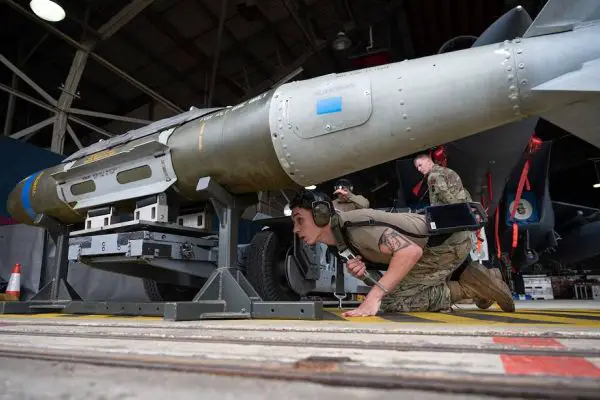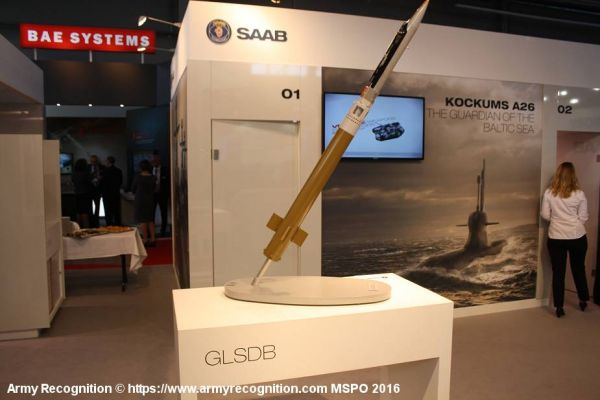Bombs.
AGM-154 JSOW Joint Standoff Weapon.

The AGM-154 JSOW is a precision-guided, long-range glide bomb developed by Raytheon for the U.S. Navy and Air Force. It allows aircraft to strike from beyond enemy air defenses, making it a versatile tool in modern warfare.
Country users: Australia, Canada, Finland, Greece, Morocco, Netherlands, Poland, Qatar, Saudi Arabia, Singapore, Taiwan, Türkiye, Ukraine, United Arab Emirates, United States
Description
The AGM-154 Joint Standoff Weapon (JSOW) is a long-range, precision-guided glide bomb developed by Raytheon for the U.S. Navy and Air Force. Its primary purpose is to enable aircraft to engage targets beyond enemy air defenses' reach, offering greater flexibility and safety during strike missions. The JSOW is known for its adaptability, capable of carrying various warheads tailored for different mission profiles.
Raytheon Technologies, a leading U.S. defense contractor, is the manufacturer of the AGM-154. Development of the JSOW began in the early 1990s as part of an initiative to create a low-cost, multi-role standoff weapon. The goal was to allow aircraft to attack diverse targets, including air defense systems and hardened installations, without the need to enter hostile airspace. The weapon entered service with the U.S. Navy in 1999 and was subsequently adopted by the U.S. Air Force in 2000.
Several countries use the AGM-154, including the United States, Saudi Arabia, Australia, Poland, Greece, Finland, and Turkey. It has been employed in a wide range of combat operations. In the 2003 Iraq War, the JSOW was instrumental in destroying surface-to-air missile sites and other key military installations. During the Afghanistan conflict, it was used for precision strikes on enemy infrastructure. In Syria, the weapon has been deployed against ISIS targets, particularly to destroy fortified positions and high-value assets. Additionally, the AGM-154C-1 variant has been used in anti-ship missions, demonstrating the weapon’s versatility in both land and maritime combat scenarios.
AGM-154 JSOW variants:
- AGM-154A: Baseline version with BLU-97/B Combined Effects Bomblets for area attacks on soft targets, such as vehicles, personnel, and surface-to-air missile sites.
- AGM-154A-1: Foreign Military Sales (FMS) version carrying a 500-pound BLU-111 unitary warhead, suitable for focused explosive impact against fixed targets.
- AGM-154C: Equipped with a BROACH multi-stage penetrating warhead, designed for hardened and fortified targets like bunkers and command centers.
- AGM-154C-1: Anti-ship variant featuring the BROACH warhead and a Link-16 data link, enabling in-flight target updates for precision strikes against moving naval targets.
- AGM-154B: Proposed variant with BLU-108 Sensor Fuzed Weapon (SFW) submunitions for anti-armor missions, later canceled.
Technical Data
-
Design
The AGM-154 JSOW is a glide bomb that lacks a rocket motor, relying instead on aerodynamic lift and gravity for propulsion. Its modular airframe incorporates pop-out wings and tail fins that deploy after release, giving it extended range and stability during flight. The design allows for long-distance travel, ensuring that the launching aircraft remains outside enemy air defense zones. The JSOW is 4.1 meters (160 inches) long, has a wingspan of 2.69 meters (106 inches), and weighs approximately 485 kg (1,065 pounds). Its box-shaped body has a 33 cm (13-inch) cross-section.
-
Warhead
The AGM-154 JSOW is adaptable to different mission profiles, with several warhead options available. The AGM-154A is equipped with BLU-97/B Combined Effects Bomblets, designed for area attacks on soft targets like vehicles, personnel, and surface-to-air missile sites. The AGM-154A-1, typically available for foreign military sales (FMS), carries a 500-pound BLU-111 warhead, suited for more traditional high-explosive missions. For strikes on hardened targets such as bunkers and command centers, the AGM-154C variant uses the BROACH (Bomb Royal Ordnance Augmented Charge) multi-stage warhead, which provides enhanced penetration capabilities. The AGM-154C-1 is specifically tailored for anti-ship missions and features the same BROACH warhead for precision strikes on maritime targets.
-
Guidance Systems
The AGM-154 JSOW employs advanced guidance systems to ensure high-precision engagement of targets. For midcourse navigation, it uses a combination of Inertial Navigation System (INS) and Global Positioning System (GPS) guidance. The AGM-154C and AGM-154C-1 variants also include a terminal Imaging Infrared (IIR) seeker, which provides enhanced accuracy during the final phase of flight, ensuring precise targeting of high-value or heavily fortified targets. The JSOW C-1 variant further integrates a Link-16 data link, allowing for real-time target updates during flight. The Circular Error Probable (CEP) of less than 3 meters ensures exceptional accuracy across all variants.
-
Combat Use
The AGM-154 JSOW is primarily designed for standoff attacks, allowing tactical aircraft to engage high-value or heavily defended targets from a safe distance, far beyond the range of enemy air defenses. This capability makes it particularly effective for Suppression of Enemy Air Defenses (SEAD) missions, where aircraft can neutralize enemy radar and missile sites without risking exposure. Additionally, the JSOW is highly effective in precision strikes on fortified positions, such as bunkers or command centers, and in targeting critical infrastructure like surface-to-air missile (SAM) sites. Its extended range of up to 130 km enables pilots to release the weapon from high altitudes, keeping their aircraft well clear of hostile anti-aircraft systems while delivering accurate and effective firepower. Its standoff range can vary from 22 to 130 kilometers, depending on altitude and release conditions.
In maritime operations, the AGM-154C-1 variant of the JSOW, equipped with a unitary warhead and infrared seeker, is designed for anti-ship missions. This variant allows air forces and naval aviators to engage enemy vessels at significant standoff distances, minimizing the risk of counterattack from naval air defenses. The JSOW’s versatility in both land and naval combat environments makes it a crucial asset for modern air and naval forces, as it can neutralize enemy ships and fortifications without exposing aircraft to direct threats.
Tactically, the JSOW is adaptable to various mission profiles. It can be used for pre-emptive SEAD missions to clear the way for follow-on aircraft by disabling enemy air defense systems. Additionally, its BROACH warhead enables it to penetrate deeply fortified structures, making it ideal for strikes against bunkers or buried targets. The cluster munitions variant of the JSOW can effectively engage dispersed soft targets, such as troop concentrations or vehicle convoys.
The JSOW can be deployed from a variety of aircraft platforms, enhancing its operational flexibility. The F/A-18 Hornet and Super Hornet, used extensively by the U.S. Navy, are among the primary launchers of the JSOW, both in land-based and carrier-based missions. The F-16 Fighting Falcon, widely used by the U.S. Air Force and allied nations, is another key platform for precision strike missions with the JSOW. The long-range strike capability of the F-15E Strike Eagle makes it well-suited for deep penetration missions, while the F-35 Lightning II can carry the JSOW internally, allowing for standoff precision strikes while maintaining a low radar signature. Additionally, the B-52 Stratofortress, with its ability to carry large quantities of munitions, can deliver mass JSOW strikes in wide-area combat operations.
Specifications
-
Type
Air-to-surface glide bomb
-
Country users
Australia, Canada, Finland, Greece, Morocco, Netherlands, Poland, Qatar, Saudi Arabia, Singapore, Taiwan, Türkiye, Ukraine, United Arab Emirates, United States
-
Designer Country
United States
-
Guidance System
GPS/INS (Global Position/Inertial), Terminal IR Seeker (AGM-154C unique)
-
Launcher Aircraft
- Navy: F/A-18 C/D, F/A-18 E/F, AV-8B and F-35C
- Air Force: F-16 Block 40/50, B-1, B-2, B-52, F-15, F-117, A-10, F-35A -
Accuracy
Circular Error Probable (CEP) of less than 3 meters
-
Launch Weight
483 kg
-
Warhead
AGM-154A/145 BLU-97 combined-effects bomblets; AGM-154A-1, 500-pound BLU-111 warhead (FMS only), AGM-154C, Broach multi-stage warhead
-
Range
Low-altitude, 22.2 km (12 nautical miles); high-altitude, 129.6 km (70 nautical miles)
-
Dimensions
Length: 4.1 m; Diameter: 33,02 cm; Wingspan: 2.69 m




































